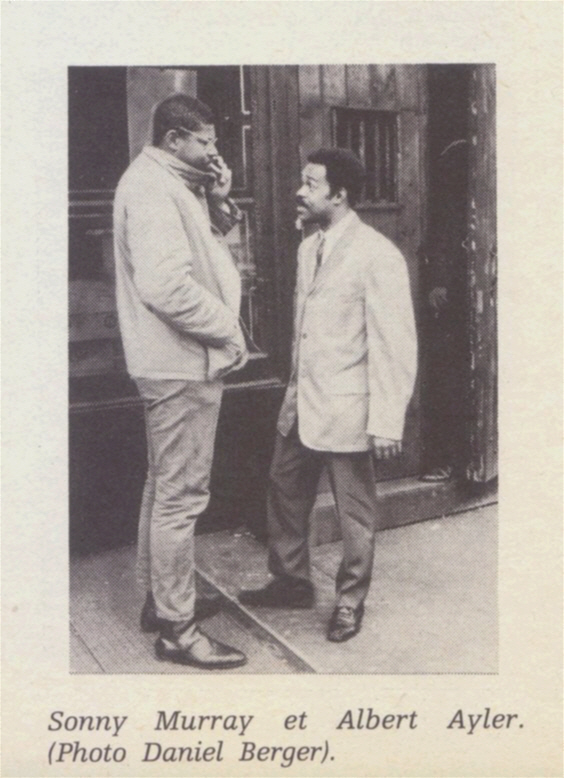|
Music Is The Healing Force Of The Universe The Inconsistency of |
|
|
||||||||||||||||
|
October 1 2019
Bibliography Creative Improvised Music: An International Bibliography of the Jazz Avant-Garde, 1959-Present by John Gray has recently been published by the African Diaspora Press, which describes it thus: “For almost three decades Fire Music, the author’s acclaimed 1991 bibliography, has been the standard reference work on the jazz avant-garde. Now, at long last, we have its companion. Creative Improvised Music picks up where that volume left off, focusing on the literature on American free jazz and European free improvisation published since the early 1990s, as well as older works and archival material not included in its predecessor. In this new iteration users will find information not only on the music’s pioneers but also on hundreds of other improviser-composers, ensembles, and collectives which have emerged in recent years. The current volume is organized into three easy to navigate sections—General Works; Regional Studies; and Biographical and Critical Studies—allowing users to quickly access the information they need. It also includes a detailed subject index which offers a key to all of the book's sections and another way to quickly pinpoint citations by topic, geographical location, personal name, and instrument.” Pierre Crépon interviews John Gray in the current online edition of The Wire, covering all aspects of his work, including its origins and its particular difficulties. I will take the liberty of extracting this part, since it provides a useful booklist: ‘Are there recent works you would single out as particularly important? Yes. For those seeking an introduction to the published literature on the music I would of course recommend both Fire Music and Creative Improvised Music, as well as Jeff Schwartz’s recent Free Jazz, an annotated bibliography published in 2018. For the free jazz/creative improv movement and its history I would suggest Ian Anderson’s This Is Our Music, a scholarly look at the music’s development during the 1960s and George Lewis’s A Power Greater Than Itself, an in-depth portrait of Chicago’s Association for the Advancement of Creative Musicians. For developments of the 1970s, including the New York loft scene, two works stand out: Bill Shoemaker’s Jazz In The 1970s and Michael Heller’s Loft Jazz. I would supplement these with two early social histories which have recently been reissued, Val Wilmer’s As Serious As Your Life and Philippe Carles and Jean-Louis Comolli’s Free Jazz/Black Power, a French Marxist perspective from 1971 now available in English translation. For free improv I would suggest John Corbett’s A Listener’s Guide To Free Improvisation, a primer that offers a non-technical guide to the music’s recorded legacy. Out of the many biographies and memoirs published over the last three decades I would single out three: Lewis Porter’s critical biography John Coltrane: His Life And Music, John Szwed’s Space Is The Place, a masterful portrait of Sun Ra, and Songs Of The Unsung, a rich oral history from Los Angeles pianist and bandleader Horace Tapscott edited by Steven Isoardi.’ * Art |
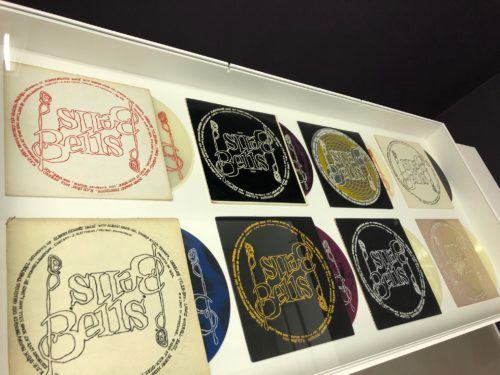 |
|
This display of Bells LPs is from an event, ‘Pieces of Peace & Fire’, at the Trondheim Kunsthall in Norway which took place from 22nd to 28th August, featuring the work of Mats Gustafsson. Dirk Goedeking found it on Mats Gustafsson’s site. And I came across news of an exhibition at New York’s Whitney Museum of American Art by Jason Moran which features works based on three legendary jazz venues including Slugs’ Saloon: |
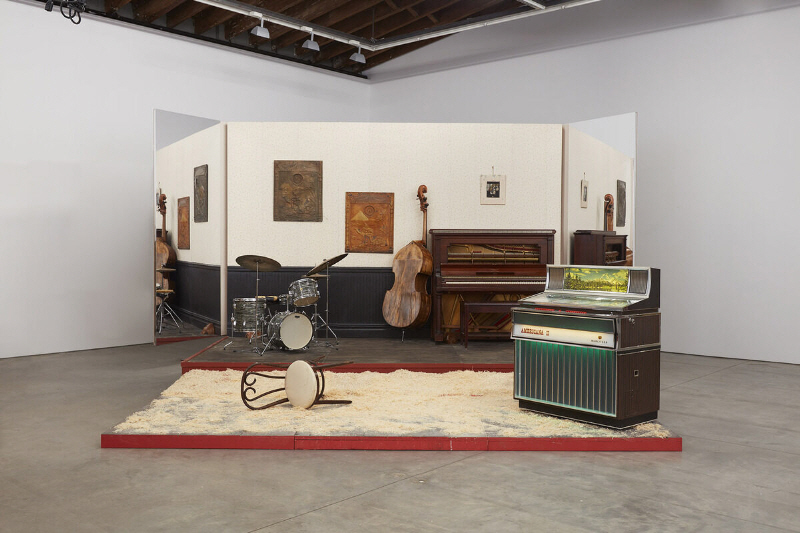 |
|
‘STAGED: Slugs’ Saloon draws upon the architectural features of the iconic jazz venue it’s titled for to evoke an atmospheric scene. More dive bar than jazz club, Slugs’ Saloon was a long, narrow space with exposed-brick walls, colored light fixtures, a mural by painter Bob Thompson, and floors covered in sawdust. Located on East Third Street between Avenue B and Avenue C in New York’s then seedy Alphabet City from 1964 to 1972, it was home to the experimentalists of free jazz, including Albert Ayler, Jackie McLean, Sun Ra’s Arkestra, Pharoah Sanders, and Cecil Taylor. With mirrors that swing out from the sides of the bandstand—a notable departure from the original Slugs’—Moran’s installation features a multitiered platform with a wooden floor, vintage upright piano, and drum set. On its lower level sits a single chair and a Wurlitzer Americana II jukebox, surrounded by sawdust and programmed with whistling tunes and audience incantations from the Village Vanguard, where Moran and The Bandwagon have a standing gig every third week of November.’ * Film I could mention buses, but I won’t. After last year’s release of a ‘lost’ Coltrane album, Both Directions At Once, another one has popped up - Blue World, a collection of tracks by the classic quartet, recorded, between Crescent and A Love Supreme, for the soundtrack of a French-Canadian film by Gilles Groulx, Le Chat Dans Le Sac (The Cat In The Bag - so close). Here’s a track:
|
|
There’s an informative review on The Quietus, and the film itself is available on youtube. Très Jean-Luc Godard.
|
|
I realise we’re wandering away from Albert Ayler here, but indulge me a little further. I rejected the following bit from last month’s entry since I reckoned it was probably not as great a revelation to anybody else as it was to me, but that Quietus review mentions Jimmy Giuffre, so that brought it back to mind. I was looking through the Free Classic Movies site and came across Daughter of Horror (aka Dementia) which carried the description: “Stupid Awful Excuse for a Movie” and “DO NOT WATCH THIS MOVIE!”. But, obviously intrigued, not least because there was a mention of Shorty Rogers and jazz, I watched it and lo and behold, around the 43 minute mark, there was Shorty Rogers and his Giants, including Jimmy Giuffre on tenor and, I presume, John Graas on french horn. So apologies if I’m teaching my grandma to suck eggs, but it was new to me, and quite exciting (I live a very quiet life). The film is also on youtube and at the Internet Archive, so, take your pick. And, in a vain attempt to drag the subject back to the world of Albert Ayler, here’s en episode of ‘Jazz Scene USA’ from 1962 featuring Shorty Rogers and his Giants, sans Jimmy Giuffre, but with Gary Peacock on bass.
|
|
Albert Mingus So, back to the world of Albert Ayler, and another of those Russian mp3 compilations of his complete works which Dirk Goedeking keeps finding. This was “part of the Russian 6 CD set formerly sold by ‘yukiss.ru’, now by ‘At Home Collection’. The set was on sale on auctions.yahoo.co.jp for two weeks, but momentarily it has disappeared.” |
 |
|
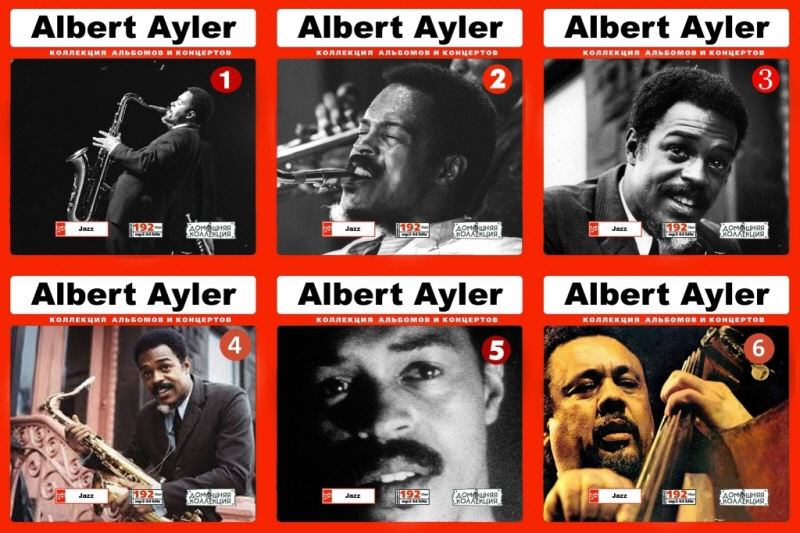 |
|
|
Italy The following is from the programme for this year’s Lecco Jazz Festival: |
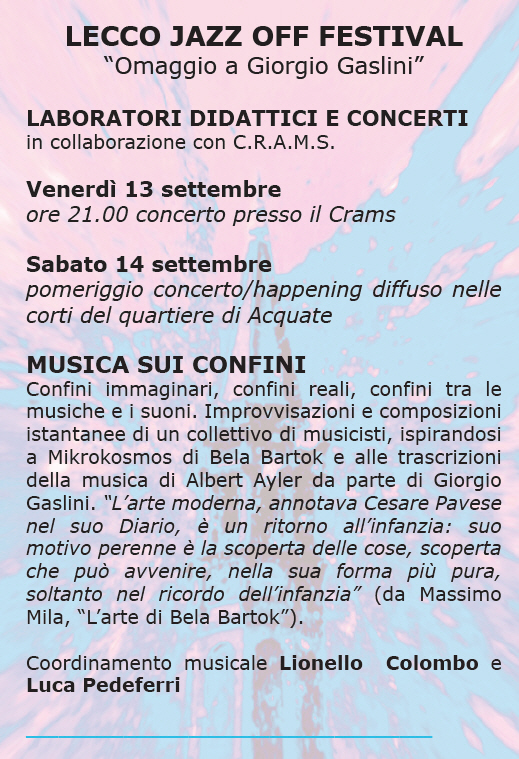 |
|
Which translates (roughly) as: LECCO JAZZ OFF FESTIVAL “Tribute to Giorgio Gaslini” EDUCATIONAL AND CONCERT WORKSHOPS Friday, September 13th Saturday, September 14th MUSIC ON THE BOUNDARIES Musical coordination Lionello Colombo and Luca Pedeferri.” * Madness And staying in Italy, I came across this on the Il Manifesto site. |
 |
|
‘An illustration that appeared in 1956 in La Tribuna Illustrata tells the story of a jazz orchestra in Amsterdam whose performers accompanied the music “with shouts, jumps, hysteria contortions and excitement communicated to the public. Then two policemen, believing that the conductor of the orchestra had been seized by an access of madness, seized him, dragged him into his dressing room and here subjected him to a prolonged cold shower.”’ It’s the illustration to an article by Flavio Massarutto about jazz and madness and comics, entitled ‘The Rhythm of Possession’, which is introduced with the following: “For decades jazz has been associated with madness and mental alterations. A music burdened by stereotypes that have thickened essays and comics often dominated by the account of the psychological discomforts of the artists. In 1913 a US comic tells the adventures of an African-American flutist whose ragtime unleashes insane dances. In 2007 Albert Ayler takes us out of the body.” Of course, Albert gets a mention because of the Astral Project manga as well as his perceived mental state, but I found the whole article interesting. So much so that I stuck the English translation on a separate page should you run into difficulties with the link to Il Manifesto. I found myself caught in some kind of registration loop when I tried it again and then, when I was asked to fill in a profile thingy, got a bit paranoid. Il Manifesto is, after all, a Communist paper, and now that Bingo Little and Gussie Fink-Nottle seem to be taking their orders from Roderick Spode, and the Daily Mail, condemning one of the Scottish judges who ruled against the spiffing wheeze of shutting down Parliament for five weeks, described him as a ‘jazz lover’, I thought it best to err on the side of caution. * Rashied Ali, Louis Belogenis and Wilber Morris – Live At Tonic ‘Heavenly Star (Dedicated To Albert Ayler)’ comes in around the 50 minute mark.
|
|
What’s New June - September 2019 is now in the Archives. ***
October 7 2019
Bill Folwell (1/5/1939 - 2/10/2019) Sad to report the passing of Bill Folwell. He played bass in the bands of Albert Ayler from 1966 to 1969, and his recordings span the 1966 European tour to the final Impulse LPs. Kees Hazevoet sent me the news, which he’d picked up from a Noal Cohen posting on the Jazz Research List. It included a link to this brief obituary from the Tampa Bay Times. Bill’s career, of course, was not confined to his time with Ayler and several years ago he sent me a copy of an extensive interview he’d done for WKCR-FM in 2007, which you’ll find in the Interviews section. Also, only a few months ago, Marc Chaloin’s interview with Bill from 1998, was published (edited by Pierre Crépon) in Point of Departure. Bill also recently recorded two albums with The Oddyssey Quartet, Suite for the End of the Earth and We Are All Branches of the Same Tree. |
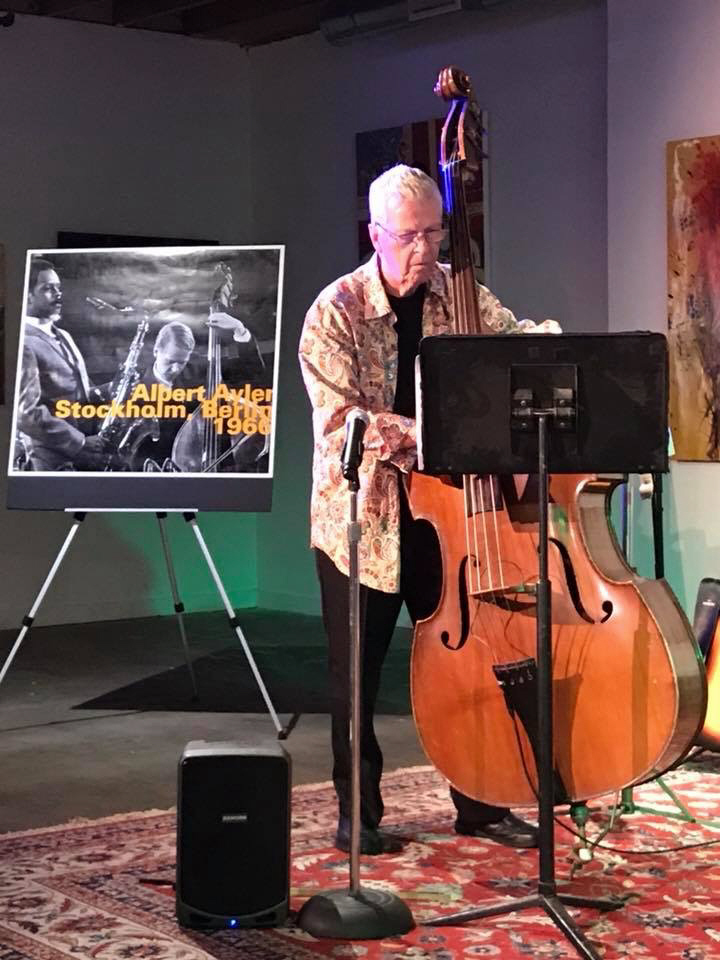 |
|
November 1 2019
Spiritual Unity and Prophecy Dirk Goedeking spotted this in the sleevenotes of Hathut’s recent release, Albert Ayler Quartets 1964 - Spirits To Ghosts Revisited: |
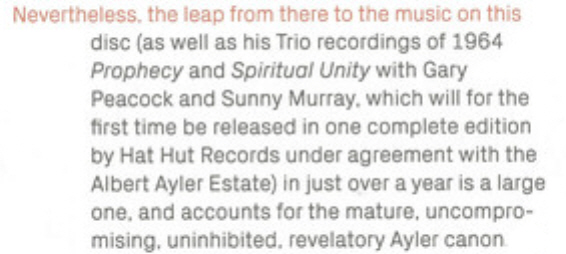 |
|
Which, Dirk and I agree, makes perfect sense - ESP’s earlier decision to twin Bells with Prophecy always seemed a bit wrong - but, still, the move to Hathut does seem to be messing with an icon. We shall see. * Dirk also let me know that Volume 1 of the Astral Project manga, mentioned last month, is available online. And he also sent this photo of Albert Ayler with Sunny Murray, but no indication of when or where it was taken. |
|
|
|
À la recherche du temps perdu And speaking of Sunny Murray, there’s one of his entertaining interviews in The East Village Other from 22nd September, 1970 on page 15 and concluded on page 22. So, I came across the Independent Voices site, which is ‘An Open Access Collection of an Alternative Press’, or, to put it another way, a cornucopia of old underground hippy magazines. A search for Albert Ayler brought up a lot of strange stuff, nothing weirder than the fact that the old hippies did seem to go for New Grass and the late Impulse LPs. I suspect drugs had been taken. From the Ann Arbor Argus (Vol. 1, No. 4, March 28-April 11, 1969 - p. 9): |
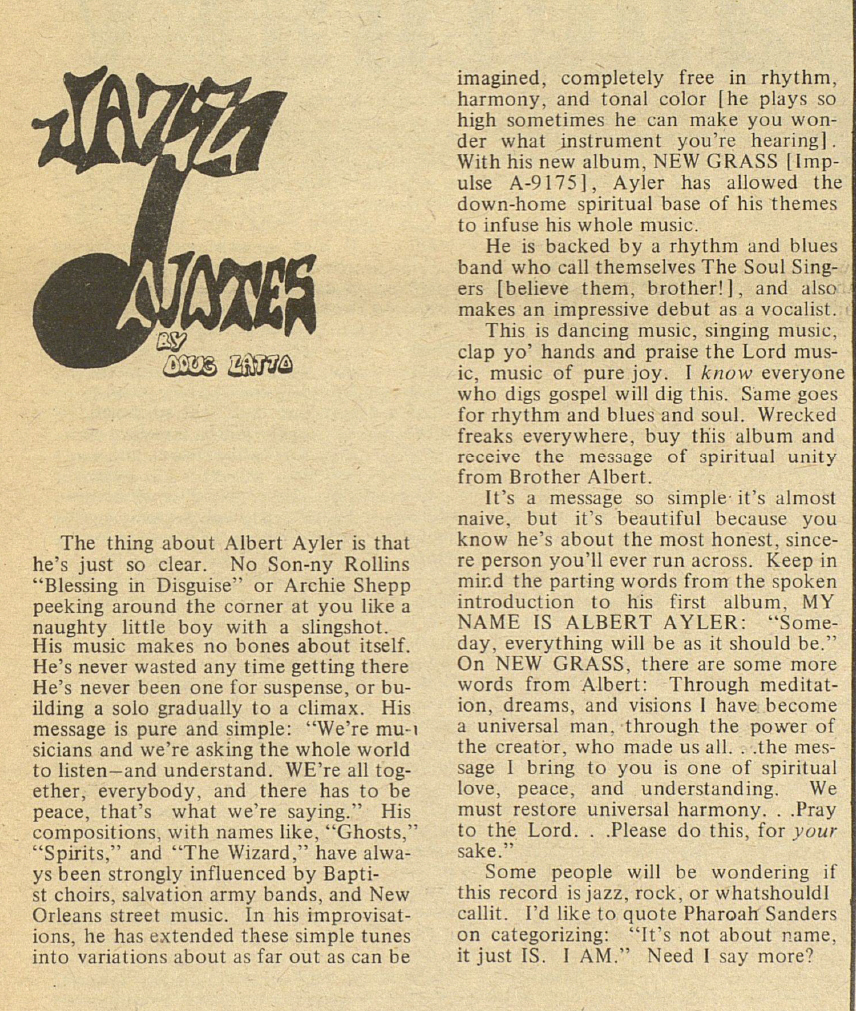 |
|
Or this from The East Village Other (14 March, 1969 - p. 13): |
||||
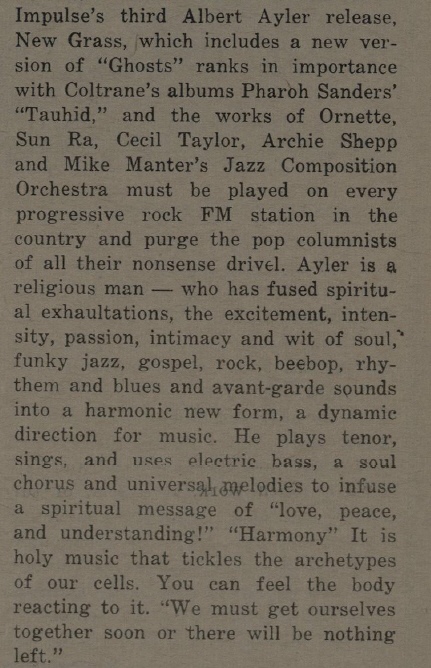 |
||||
|
And the enthusiasm never waned, here’s The Last Album reviewed in The East Village Other, (14 July, 1971 - p.10): |
||||
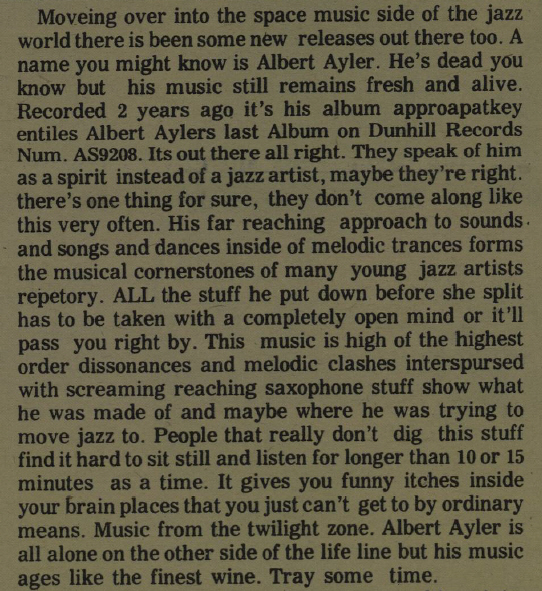 |
||||
|
It’s not all daft though, this is a review of the Albert Ayler at the Astor Place Playhouse in February 1966 (fronting a band which included brother Don, Charles Tyler, Joel Freedman and Charles Moffett) from The East Village Other, (Volume 1, No. 8, March 15 - April 1, 1966 - p. 5): |
||||
 |
|
And there are other mentions of concerts, including this wonderful line-up for the Perspective In Revolution concert series organised by Lovebeast Enterprises (“the animal loves you wear it in your eyes ...”), from The East Village Other (Volume 1, No. 16, July 15 - August 1, 1966 - p. 10): |
||||||||||||||||||
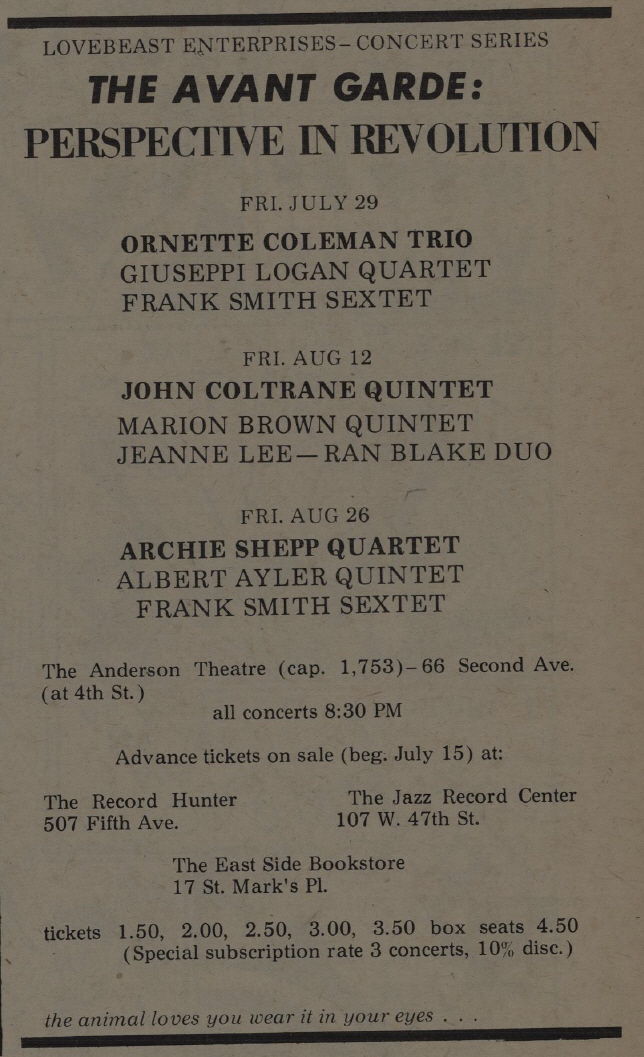 |
||||||||||||||||||
|
And this preview of Don Ayler’s Town Hall concert from The East Village Other (10 January, 1969 - p. 9) which raises questions regarding the line-up of those two revelatory Don Ayler tracks on Disc 7 of the Holy Ghost boxset: |
||||||||||||||||||
 |
||||||||||||||||||
|
There are a couple of extensive articles, one by Duck Baker on ‘Ayler’s Apocalyptic Sound’ in the Berkeley Barb (Volume 21, No. 24, July 4-10, 1975 - p.13), and an article by Mike Bourne, ‘The Real Art Music’ from The Spectator (not that one) (13 May, 1969, pp.19-20), which calls Ayler, Coltrane, Sun Ra and Cecil Taylor mainstream and hails the coming of the AACM and the JCOA - page 1, page 2 (nod to friend Clive, page 2 also has a review of The Hangman’s Beautiful Daughter by The Incredible String Band). And a review (in the Berkeley Barb (Volume 20, No. 4, August 9-15, 1974 - p.13) of a ‘new’ magazine, Bells, which rang one, and I checked and found a broken link back in November 2007 to a site with all the issues of Bells online, which has now moved here. But apart from the whiff of patchouli oil, the other delights of this wander through the past are those hints at paths not taken, or shards of synchronicity. From The East Village Other (Volume 3, No.18, April 5 - 11, 1968 - p. 6): |
||||||||||||||||||
 |
||||||||||||||||||
|
From The Spectator, (29 April, 1969 - p. 19): |
||||||||||||||||||
 |
||||||||||||||||||
|
Back to the land of the living Steve Tintweiss writes: “Great show of free-form avant-garde jazz University of Virginia, Charlottesville Broadcast is still available for a few more days online under Recent Programs. ‘Point of Departure’ includes my new Spacelight Band INKY DoT MEDIA release side A 45rpm 12” single ‘Whistle Stop Tour/I Lust You’ 48:30 into the 2 hour show.” https://www.wtju.net/Recent-shows/ and select October 21 ‘Point of Departure’. * And (in the spirit of Halloween) the undead A rather jaunty Russian (?) version of ‘Ghosts’. Speaking of which, this from the San Francisco Good Times (15 January, 1971 - p. 19): |
||||||||||||||||||
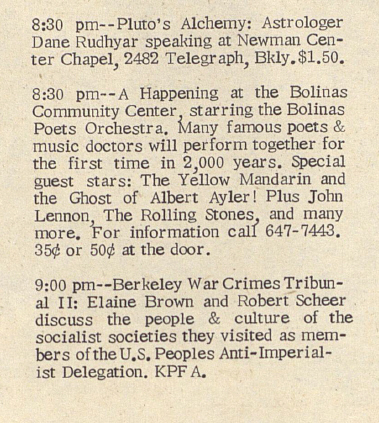 |
||||||||||||||||||
|
And this, I’ve no idea:
|
||||||||||||||||||
|
December 1 2019
Joy to the World Well, ’tis the season to be jolly and with ‘those in the know’ predicting a landslide victory for Bingo Little and his pals on December 12th, let the bells ring out and bring this year to a merry end with Christmas greetings from Albert Ayler. |
||||||||||||||||||
 |
||||||||||||||||||
|
The third volume of the Mars Williams mash-up of Albert Ayler and Christmas carols is now available on the bandcamp site: Tracklist: 1. The Hanukah-Xmas March of Truth for 12 days of Jingling Bells with Spirits Lineup: Recorded live at Alchemia, Krakow December 9, 2018. There’s a podcast with Mars Williams being interviewed by Alex Rawls on the subject of ‘An Ayler Xmas’ as part of ‘12 Songs of Christmas’, starting at 33:17. And Mars Williams will also be touring Europe and America through December. |
||||||||||||||||||
 |
|
Bernard Stepien - A Very Ayler Christmas Of course other Ayler/Christmas mash-ups are available, and what I believe was the first of them, Bernard Stepien’s ‘A Very Ayler Christmas’, is having its annual workout at GigSpace, Ottawa on 14th December as part of the Ron Sweetman Jazz Tribute Concert Series. On the GigSpace site Bernard writes: “I met Ron Sweetman at one of the concerts I organized with Archie Shepp at the Theatre the l'île in Hull in 1976. We became instant friends and he supported every concert I organized in the avant-garde veine back then and even some of my own projects like playing the full répertoire of the music of Thelonious Monk and especially the A Very Ayler Christmas that we are presenting tonight at this party. The Ayler Christmas project initially started at jam sessions around Christmas where various musicians played jazzed up Christmas Carols. Saxophonist David Broscoe and myself quickly agreed that these carols could be played à la Albert Ayler with all his lyricism and frantic deviations from the original path. In 2006, more musicians got interested in the project and we all started to expand the répertoire that led to our CD release. Today, this project is well oiled to the point that sometimes we play another carol than the one we are staring at on our music stands. While most musicologists think that Ayler played Gospel music, we think that he really played Christmas Carols in disguise.” Check out Bernard’s site and his version of ‘Joy to the World’ mixed with ‘Bells’. * Albert Ayler Christmas Shopping Bag |
|||||||||||||
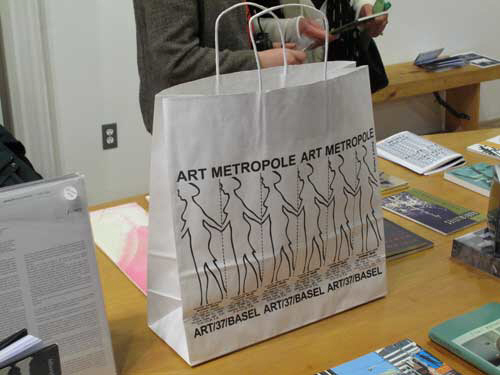 |
|||||||||||||
|
Dirk Goedeking sent me the information about the new Mars Williams CD and also his annual roundup of what’s in the shops for the Ayler fan to splurge on this Christmas, beginning with a rather prosaic acrylic tea tray: |
|||||||||||||
 |
|||||||||||||
|
A coffee table to put it on: |
|||||||||||||
 |
|||||||||||||
|
And a stylish credenza to look at while you’re drinking your tea (a snip at $486.74): |
|||||||||||||
 |
|||||||||||||
|
Now, if Dirk had called it a sideboard, I wouldn’t have got mixed up in my addled brain, confusing a credenza with a gazunda and fully expecting to see Albert’s image on a chamber pot (perhaps even manufactured here in the Potteries). No doubt that day will come, but letting Dirk know of my faux pas he sent me the following, which he had not included in his original bag: “Albert Ayler Jazz Saxophone, Discreet Tampon Case: Holds up to 8 tampons Available on amazon. |
|||||||||||||
 |
|||||||||||||
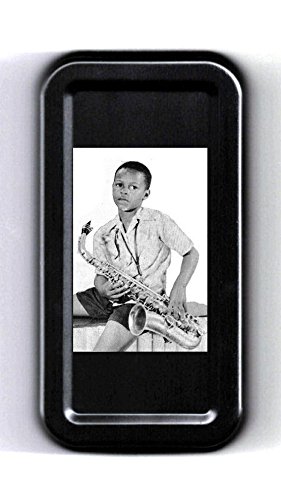 |
|||||||||||||
|
Youtube roundup Just a couple this month. The final version of ‘Ghosts’ for 2019 - this one incorporates that other youtube staple, a cat.
|
|||||||||||||
|
And here’s all five hours of the Free Jazz Meeting, December 1970 Südwestfunk Studios Baden-Baden, Germany, which begins with ‘Let's Sing For Him (March In Memory of Albert Ayler)’.
|
|||||||||||||
|
And finally . . . That’s it for this year. No more Albert Ayler, no more Free Jazz, nothing to look at here, sir, move along now. What follows is just a seasonal indulgence on my part. Just two more items I came across which I thought I’d share. The first concerns the mighty Internet Archive. An article on Open Culture, ‘The Internet Archive Is Digitizing & Preserving Over 100,000 Vinyl Records: Hear 750 Full Albums Now’, piqued my interest and I spent a pleasant half-hour among the 750. And a strange collection it is. Mainly Classical and ‘Easy Listening’ (nothing wrong with that), but there are also things like The Begatting of The President narrated by Orson Welles, a 3 LP box set of Argentinian folk songs, That Was the Week That Was: The British Broadcasting Corporation’s Tribute to John Fitzgerald Kennedy, and among the likes of The Cascading Voices Of The Hugo & Luigi Chorus with Brass you come across Dory Previn’s Mythical Kings and Iguanas and wonder how that got in there. There are names you’ve forgotten like Peter Nero, or the Hi-Lo’s, or names everyone seems to have forgotten - a group called The Group, a kind of less jazzy version of Lambert, Hendricks & Ross, which seems to have left no trace anywhere. I’m not one of those vinyl obsessives who believe that the scratches and clicks are part of the ‘full vinyl experience’, so beware, the albums have not been remastered or cleaned up in any way. The other thing might merit a place among the 750, but I found it when I was doing the regular monthly Albert Ayler search on youtube. I’d be surprised if this means anything to anybody reading this, but, back in the late 1950s there was a programme broadcast by ATV in the Midlands called Lunchbox, which was what they called a ‘magazine show’. Hosted by Noele Gordon, years before she opened her motel, and featuring a regular band, Jerry Allen and his Trio. |
|||||||||||||
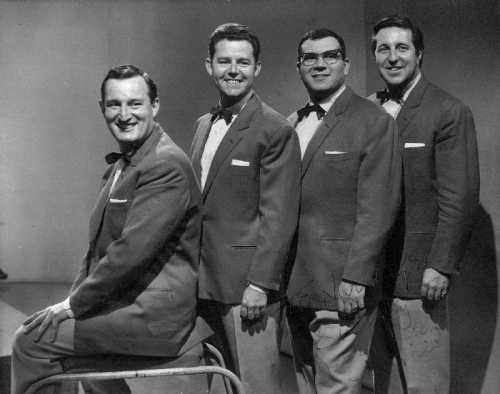 |
|||||||||||||
|
The band members, particularly Leon the drummer, took part in various ‘skits’, and for some reason, which I don’t fully understand, I always associate the show and the band with Christmas. So, why it turned up in a search for Albert Ayler I don’t know, but it gave me a nice seasonal glow, which, believe me, I need right now. Happy Christmas and, barring accidents and national disasters, hopefully I’ll be back in 2020. |
|||||||||||||
|
*** News from 2004 (January - June) 2004 (July - December) 2005 (January - May) 2005 (June - December) 2010 (January - June) 2010 (July - December) 2011 (January - May) 2011 (June - September) 2011 (October - December) 2012 (January - May) 2012 (June - December) 2013 (January - June) 2013 (July - September) 2013 (October - December) 2014 (January - June) 2014 (July - December) 2015 (January - May) 2015 (June - August) 2015 (September - December) 2016 (January - March) 2016 (April - June) 2016 (July - August) 2016 (September - December) 2017 (January - May) 2017 (June - September) 2017 (October - December) 2018 (January - May) 2018 (June - September) 2018 (October - December) 2019 (January - May) 2019 (June - September) 2020 (January - April) 2020 (May - August) 2020 (September - December) 2021 (January - March) 2021 (April - July) 2021 (August - December) 2022 (January - April) 2022 (May - August) 2022 (September - December) 2023 (January - March) 2023 (April - June) 2023 (July - September) 2023 (October - December) 2024 (January - March) 2024 (April - June) 2024 (July - September) 2024 (October - December)
|
|||||||||||||
|
Home Biography Discography The Music Archives Links What’s New Site Search
|
|||||||||||||

